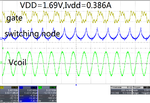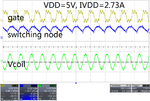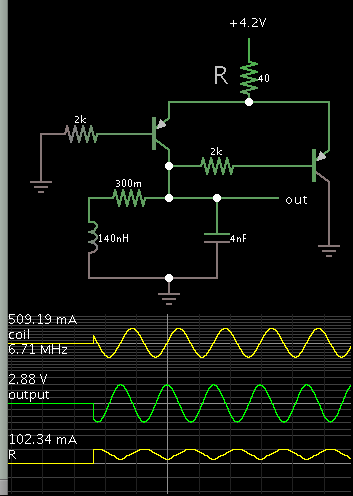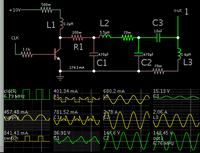bhl777
Full Member level 6
Hi All, I am new to PA and building a class E PA in driving the wireless power coil. Currently I can get the sinusoidal waveform at the coil, but it is still not functional. Would any one help me point out the problems I have?
This is my schematic.

The switching frequency is 6.78MHz. I am using the switch F12N10L,C2=33pF, L2=4.2Uh(Wurth 744325420), C3=100pF, L3 is 7.8uH (Wurth 760308103307), L1 is a large one but it seems it does not play a critical role. I am using a fucntion generator to go through a digital AND gata to drive the FET.
During my test, no secondary WPT coil is placed around. So ideally I suppose this should be like a "no load" condition. However, there are many problems of my exsiting circuits:
(1) the switching node looks wired
(2) at this no load condition, I_VDD is very high
(3) as VDD increases, the peak to peak amplitdue of Vcoil goes up first then goes down. For example, I want to have a 15V Vpeak to peak amplitude of the Vcoil, but I can never get it using the exsiting circuit.



Would any one tell me what makes this PA not functional? The perfect resonance is not necessary, but I do want to have a tunable peak to peak amplitude of the Vcoil, that I can use to transfer to the secondary coil. Thank you!
This is my schematic.

The switching frequency is 6.78MHz. I am using the switch F12N10L,C2=33pF, L2=4.2Uh(Wurth 744325420), C3=100pF, L3 is 7.8uH (Wurth 760308103307), L1 is a large one but it seems it does not play a critical role. I am using a fucntion generator to go through a digital AND gata to drive the FET.
During my test, no secondary WPT coil is placed around. So ideally I suppose this should be like a "no load" condition. However, there are many problems of my exsiting circuits:
(1) the switching node looks wired
(2) at this no load condition, I_VDD is very high
(3) as VDD increases, the peak to peak amplitdue of Vcoil goes up first then goes down. For example, I want to have a 15V Vpeak to peak amplitude of the Vcoil, but I can never get it using the exsiting circuit.



Would any one tell me what makes this PA not functional? The perfect resonance is not necessary, but I do want to have a tunable peak to peak amplitude of the Vcoil, that I can use to transfer to the secondary coil. Thank you!



